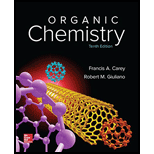
Solutions Manual for Organic Chemistry
10th Edition
ISBN: 9781259636387
Author: Carey Dr., Francis A
Publisher: McGraw-Hill Education
expand_more
expand_more
format_list_bulleted
Question
Chapter 11, Problem 45P
Interpretation Introduction
Interpretation:
The product for each of the given compounds undergoing intramolecular Diels -Alder reaction is to be given.
Concept Introduction:
The Diels-Alder reaction is the conjugate addition of an
The two double bonded carbon atoms in the dienophile constitute two possible sites of reaction.
The reaction occurs in one step without forming an intermediate.
The product of a Diels-Alder reaction always contains one more ring than the reactants.
In intramolecular Diels-Alder reaction, a molecule has three double bonds and two of them are conjugated.
Expert Solution & Answer
Want to see the full answer?
Check out a sample textbook solution
Students have asked these similar questions
Identify the reagents you would use to prepare each of the following compounds from a Diels-Alder reaction.
The following diene does not undergo a Diels-Alder reaction with maleic anhydride, both in thermal and photochemical conditions. Explain why this reaction does not occur.
Which of the following conjugated dienes will not react with a dienophile in a Diels–Alder reaction?
Chapter 11 Solutions
Solutions Manual for Organic Chemistry
Ch. 11.1 - Prob. 1PCh. 11.1 - Prob. 2PCh. 11.2 - The two compounds shown differ by a factor of 60...Ch. 11.2 - Prob. 4PCh. 11.2 - Prob. 5PCh. 11.2 - Prob. 6PCh. 11.3 - Prob. 7PCh. 11.3 - Prob. 8PCh. 11.3 - Evaluate 2,3,3-trimethyl-1-butene as a candidate...Ch. 11.4 - After heating a solution of allyl tert-butyl...
Ch. 11.5 - Prob. 11PCh. 11.6 - Prob. 12PCh. 11.8 - Prob. 13PCh. 11.9 - What dienes containing isolated double bonds are...Ch. 11.10 - Prob. 15PCh. 11.10 - Prob. 16PCh. 11.11 - Prob. 17PCh. 11.12 - Dicarbonyl compounds such as quinones are reactive...Ch. 11.12 - 2,3-Di-tert-butyl-1,3-butadiene is extremely...Ch. 11.12 - Methyl acrylate (H2C=CHCO2CH3) reacts with...Ch. 11.13 - Prob. 21PCh. 11.14 - What diene and dienophile could you use to prepare...Ch. 11.14 - Write equations in the synthetic direction for the...Ch. 11.16 - Prob. 24PCh. 11.16 - Prob. 25PCh. 11 - Write structural formulas for each of the...Ch. 11 - Give an acceptable IUPAC name for each of the...Ch. 11 - A certain species of grasshopper secretes an...Ch. 11 - Which of the following are chiral?...Ch. 11 - Describe the molecular geometry expected for...Ch. 11 - Prob. 31PCh. 11 - What compound of molecular formula C6H10 gives...Ch. 11 - Prob. 33PCh. 11 - Prob. 34PCh. 11 - Prob. 35PCh. 11 - Prob. 36PCh. 11 - Identify the more reactive dienophile in each of...Ch. 11 - Prob. 38PCh. 11 - Prob. 39PCh. 11 - Prob. 40PCh. 11 - Prob. 41PCh. 11 - Prob. 42PCh. 11 - Prob. 43PCh. 11 - Prob. 44PCh. 11 - Prob. 45PCh. 11 - Prob. 46PCh. 11 - Show how to prepare each of the following...Ch. 11 - Prob. 48PCh. 11 - Prob. 49PCh. 11 - Prob. 50PCh. 11 - Compound A was converted to compound B by the...Ch. 11 - Suggest reasonable explanations for each of the...Ch. 11 - Prob. 53PCh. 11 - Prob. 54PCh. 11 - Prob. 55DSPCh. 11 - Prob. 56DSPCh. 11 - Prob. 57DSPCh. 11 - Prob. 58DSPCh. 11 - Prob. 59DSP
Knowledge Booster
Similar questions
- Consider the following dienes in a Diels–Alder reaction with ethene. Which will react the fastest? Which will react the slowest? Explainarrow_forwardWhat is the major product of the following Diels Alder reactions?arrow_forwardWhich of the following compounds reacts most rapidly in a halogenation reaction?arrow_forward
- For each of the reactions below, the product can be formed via a Diels Alder reaction. Show the starting materials for each of the Diels Alder reactions shown below.arrow_forwardPredict the major product of the following Diels-Alder reactions with the correct regiochemistry and stereochemistry. If an enantiomer is also made, indicate the enantiomer by adding “+ EN” beside the major product. Please explain step by step.arrow_forwardDraw a product of the following reaction. Indicate the stereochemistry of the Diels-Alder product.arrow_forward
- Complete the Diels-Alder reactions by drawing structures for the products in each question.arrow_forwardExplain the stereochemistry of the product of the Diels-Alder reaction shown below:arrow_forwardFor each of the following products, draw the structures of the diene and dienophile necessary to synthesize the compound in a Diels-Alder reaction.arrow_forward
arrow_back_ios
SEE MORE QUESTIONS
arrow_forward_ios
Recommended textbooks for you
 Organic ChemistryChemistryISBN:9781305580350Author:William H. Brown, Brent L. Iverson, Eric Anslyn, Christopher S. FootePublisher:Cengage Learning
Organic ChemistryChemistryISBN:9781305580350Author:William H. Brown, Brent L. Iverson, Eric Anslyn, Christopher S. FootePublisher:Cengage Learning

Organic Chemistry
Chemistry
ISBN:9781305580350
Author:William H. Brown, Brent L. Iverson, Eric Anslyn, Christopher S. Foote
Publisher:Cengage Learning
